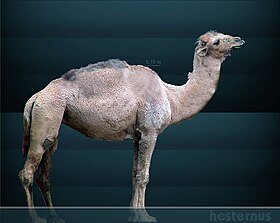Camelops
| Camelops | ||||||||||||
|---|---|---|---|---|---|---|---|---|---|---|---|---|

Camelops sp. |
||||||||||||
| Temporal occurrence | ||||||||||||
| Pleistocene | ||||||||||||
| 1.8 million years to 11,000 years | ||||||||||||
| Locations | ||||||||||||
|
||||||||||||
| Systematics | ||||||||||||
|
||||||||||||
| Scientific name | ||||||||||||
| Camelops | ||||||||||||
| Leidy , 1854 | ||||||||||||
Camelops ( Gr .: "camel face") is a genus of large camels thatlived in North Americaduring the Ice Age .
distribution
The genus Camelops lived from the late Pliocene to the late Pleistocene in the western half of North America. Six different types are known, but not all of them may be valid. The last living Camelops species was the western camel ( C. hesternus ), from the late Pleistocene, which only became extinct about 10,000 years ago. About 40 individuals of this species were found in Rancho La Brea in California , and they even reached the Yukon River in the north . In addition to camelops , two other, somewhat smaller camel species lived in North America in the late Pleistocene. They belonged to the genera Palaeolama and Hemiauchenia and died out around the same time as Camelops . With these three species, the camels suddenly disappeared from North America, after having undergone most of their evolutionary development here over millions of years.
Appearance
Although Camelops with the small camel was more closely related than with the United camels , it reminded the appearance rather of a present-day dromedary ( Camelus dromedarius ). It probably also had a hump in the middle of the back, but in Camelops the rear part sloped more and the legs were even longer than in today's species.
Way of life
Camelops lived in the drier tracts of western North America and were apparently primarily a herbivore. It evidently wandered around in large herds at times . Some finds, such as those from Burnet Cave and Jaguar Cave, can be linked to human remains.
literature
- Paul S. Martin , Richard G. Klein (Eds.): Quaternary Extinctions. A Prehistoric Revolution. The University of Arizona Press, Tucson AZ 1984, ISBN 0-8165-1100-4 .
